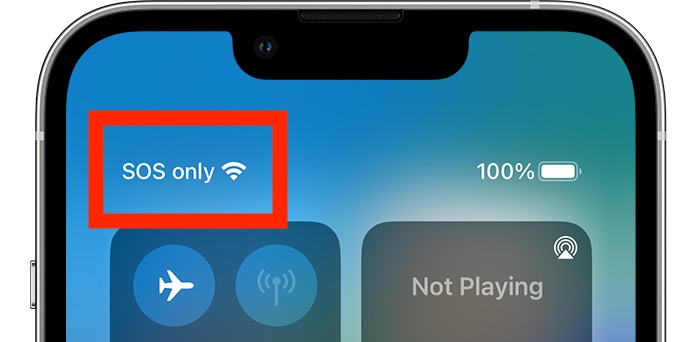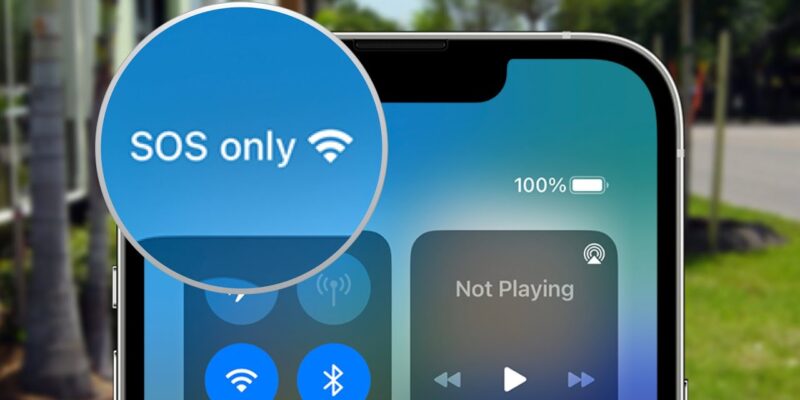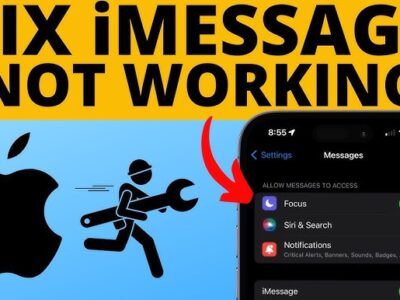If you’re a Verizon customer, seeing “SOS” where your signal strength should be is a major concern. It’s more than just an inconvenience – it means you’re disconnected from the network, unable to make calls, send texts, or use mobile data.
In this post, we’ll break down what “SOS Verizon” means, why it happens, and most importantly, how to get back online.
What Is SOS?
SOS is an internationally recognized distress signal used to call for help in emergency situations. It’s most commonly associated with Morse code, where it’s represented by three dots, three dashes, and three dots (…—…). However, the SOS signal can also be transmitted through other means, such as visual signals (like flashing lights), audio signals (like a siren), or even by writing the letters SOS in the sand or snow.
Here’s a quick overview of SOS:
Origins:
- Morse Code: SOS was first introduced in 1906 as a Morse code distress signal due to its simplicity and easy recognition.
- Not an Acronym: Contrary to popular belief, SOS isn’t an acronym for “save our ship” or any other phrase. The letters were chosen for their distinctiveness in Morse code.
Usage:
- Maritime: SOS is traditionally associated with maritime distress, used by ships in danger to call for rescue.
- Other Uses: The signal has expanded beyond maritime use and is now widely recognized as a general distress call in various situations, including aviation, land emergencies, and personal emergencies.
How It Works:
- Universal Signal: SOS is not language-specific, making it understandable across different cultures and languages.
- Simple and Distinctive: The pattern of three dots, three dashes, and three dots is easy to remember and transmit, even under duress.
Modern Relevance:
- Mobile Phones: Many mobile phones have an SOS feature that allows users to quickly call emergency services or send a distress message to designated contacts.
- Emergency Beacons: Personal locator beacons (PLBs) and emergency position-indicating radio beacons (EPIRBs) use SOS signals to transmit distress signals with location information.
Examples of SOS Usage:
- A sinking ship sending an SOS message via radio.
- A stranded hiker using a mirror to flash an SOS signal.
- A person in a remote area using their phone’s SOS feature to call for help.
While we hope you never need to use it, understanding the meaning and significance of SOS can be invaluable in emergency situations.
Understanding “SOS Verizon”

The appearance of “SOS” (or “SOS Only”) on your Verizon phone’s signal bar is more than just a minor inconvenience. It’s a glaring indicator that your device is currently severed from the cellular network, leaving you stranded without access to the usual conveniences of modern communication.
This means:
- No Connection, No Conversation: Forget about making or receiving calls, even simple text messages won’t reach their destination.
- Data Drought: Your phone becomes a digital island, cut off from the vast expanse of the internet. No social media scrolling, no map directions, no streaming your favorite shows.
- App Abandonment: Any app that relies on cellular data to function will be rendered useless. This includes everything from ride-sharing apps to your banking tools.
The Silver Lining: SOS Calls
While the situation may seem dire, there’s a crucial lifeline embedded in that “SOS” message. It signifies that, despite the lack of general network access, your phone retains the ability to connect to emergency services.
Here’s how it works:
- Emergency Mode: When your phone detects no Verizon signal, it automatically switches to a special mode that prioritizes emergency calls.
- Network Agnostic: It scans for any available cellular network, regardless of your carrier, to establish a connection.
- Lifeline: If it finds a signal, it allows you to dial 911 (or your local emergency number) to reach first responders.
The Psychological Impact
The ability to make emergency calls is undeniably essential, but it doesn’t eliminate the frustration that comes with “SOS Verizon.” It’s a sudden disconnect from the digital world, a reminder of our reliance on technology, and a potential source of anxiety, especially if the disconnection occurs in an unfamiliar or remote location.
Understanding that “SOS Verizon” is not the same as having “no signal” at all is crucial. “No signal” implies a complete inability to connect to any network, even for emergencies. “SOS” signifies a more nuanced state of disconnection – a frustrating interruption of regular services, but with a critical lifeline still intact.
Why Does “SOS Verizon” Happen?
Let’s dive deeper into the reasons why you might encounter the dreaded “SOS Verizon” message on your phone:
- No Service Area (Dead Zones):
- Rural Areas: Verizon, like all carriers, has a network of cell towers. If you’re in a remote area far from these towers, your phone may struggle to connect, resulting in “SOS.”
- Buildings and Obstacles: Thick walls, underground locations, or even certain building materials can block cellular signals, leaving you with no service.
- Temporary Outages: Sometimes, Verizon may be conducting maintenance or experiencing technical issues with specific towers, leading to temporary service disruptions in localized areas.
- Account Issues:
- Unpaid Bills: If your Verizon account has an outstanding balance, your service may be temporarily suspended, causing your phone to show “SOS.”
- Suspended Lines: Your line could be suspended due to inactivity, suspected fraud, or other reasons, resulting in a loss of connection.
- Roaming Restrictions: If you’re traveling internationally and don’t have an international roaming plan, your service may be restricted, leading to “SOS.”
- SIM Card Problems:
- Damaged SIM: A scratched, bent, or cracked SIM card can prevent your phone from properly communicating with the network.
- Improper Insertion: If your SIM card isn’t inserted correctly in the SIM card tray, it may not make proper contact, leading to connection issues.
- Outdated SIM: In rare cases, an older SIM card may not be compatible with newer network technologies, resulting in “SOS.”
- Device Issues:
- Software Glitches: Sometimes, bugs in your phone’s operating system or a misconfigured setting can interfere with the network connection.
- Hardware Problems: Damage to your phone’s antenna, radio chip, or other components responsible for cellular connectivity can cause “SOS.”
- Carrier Settings: Outdated carrier settings (the configurations your phone uses to connect to Verizon’s network) can sometimes cause problems.
- Network Congestion:
- High Traffic Events: During large gatherings like concerts, festivals, or sports events, the sheer number of people using their phones in the same area can overwhelm the network, leading to connection problems.
- Emergencies: In times of crisis, a surge in calls and texts can also strain the network, causing it to prioritize emergency calls (hence the “SOS”) over regular traffic.
- Other Factors:
- Airplane Mode: If your phone is in airplane mode, it will intentionally disconnect from all cellular networks.
- Carrier Switching: If you’ve recently switched carriers or are using a phone not specifically designed for Verizon, there could be compatibility issues.
How to Fix “SOS Verizon”

Here’s a comprehensive guide on how to fix the “SOS Verizon” issue, catering to both tech-savvy users and those who prefer simpler solutions:
Basic Troubleshooting:
- Restart Your Phone: A classic fix that often works wonders. Simply turn off your phone, wait a few seconds, and turn it back on. This can clear up minor software glitches causing the issue.
- Check for Network Outages:
- Verizon Website/App: Visit Verizon website or use their app to see if there are any reported outages in your area.
- Social Media: Check platforms like Twitter for any mentions of Verizon outages from other users in your vicinity.
- Verify Your Account Status:
- My Verizon App: Log into the My Verizon app or website to check your bill status and ensure your account is active.
- Contact Customer Service: If you suspect an account issue, call Verizon customer service directly.
- Reseat Your SIM Card:
- Power Off: Turn off your phone completely.
- Remove SIM: Use a SIM ejector tool or a paperclip to open the SIM tray and remove the SIM card.
- Inspect: Check for any visible damage to the SIM card (scratches, bends, etc.).
- Reinsert: Gently reinsert the SIM card, ensuring it’s properly seated in the tray.
- Power On: Turn your phone back on and see if the issue is resolved.
Intermediate Troubleshooting:
- Update Your Phone’s Software:
- Check for Updates: Go to your phone’s settings and look for a “Software Update” or similar option.
- Install Updates: If updates are available, download and install them. This can often fix bugs that cause network issues.
- Reset Network Settings:
- Warning: This will erase saved Wi-Fi passwords and cellular settings, so note them down beforehand.
- Navigate to Settings: Find the “Reset Network Settings” option, usually under “General” or “System” settings.
- Confirm: Tap “Reset Network Settings” and enter your passcode if prompted.
Advanced Troubleshooting:
- Check Carrier Settings:
- iPhone: Go to Settings > General > About. If a carrier settings update is available, a prompt will appear.
- Android: Go to Settings > Connections > Mobile networks > Network operators > Search networks. Choose Verizon from the list.
- Try a Different Location: If you suspect the issue is due to a weak signal or a dead zone, move to a different location with better Verizon coverage.
If All Else Fails:
- Contact Verizon Support: If you’ve tried all the troubleshooting steps and still see “SOS,” it’s time to call Verizon customer support. They have tools to diagnose the issue remotely and can provide personalized assistance.
Important Considerations:
- Device Compatibility: Ensure your phone is compatible with Verizon’s network bands.
- SIM Card Replacement: If you suspect a faulty SIM card, visit a Verizon store to get a replacement.
- Hardware Issues: If you suspect a hardware problem with your phone, take it to a repair shop for diagnosis.
By following these troubleshooting steps, you’ll greatly increase your chances of resolving the “SOS Verizon” issue and getting back to enjoying uninterrupted service.
Preventive Measures to Avoid “SOS Verizon”
Here are some proactive measures you can take to minimize the chances of encountering the “SOS Verizon” message in the future:
- Stay Updated:
- Phone Software: Regularly check for and install software updates for your phone. These updates often include bug fixes and improvements that can enhance network connectivity.
- Carrier Settings: Keep your carrier settings up-to-date. Your phone will usually notify you when a new update is available.
- Verizon Apps: Ensure you’re using the latest versions of the My Verizon app and any other Verizon-related apps.
- Account Management:
- Timely Payments: Pay your Verizon bill on time to avoid any service interruptions due to unpaid balances.
- Usage Monitoring: Keep an eye on your data usage, especially when traveling, to avoid exceeding your limits and incurring extra charges.
- Contact Information: Ensure that your contact information with Verizon is current so they can reach you if there are any issues with your account.
- Signal Strength Awareness:
- Check Coverage Maps: Before traveling to a new area, consult Verizon’s coverage map to get an idea of the signal strength you can expect.
- Signal Booster: If you live or work in an area with weak Verizon signal, consider investing in a signal booster to improve reception.
- Wi-Fi Calling: Enable Wi-Fi calling on your phone to use Wi-Fi networks for calls and texts when cellular signal is poor.
- Device Maintenance:
- Protect Your Phone: Use a case and screen protector to safeguard your phone from physical damage that could affect its antenna or other components.
- Avoid Extreme Temperatures: Don’t expose your phone to extreme heat or cold, as this can affect battery life and potentially damage internal components.
- Network Congestion Strategies:
- Off-Peak Usage: If possible, try to make calls and send texts during off-peak hours when the network is less congested.
- Prioritize Wi-Fi: When you’re in crowded areas, connect to Wi-Fi networks to reduce the strain on cellular networks.
- SIM Card Care:
- Handle with Care: When removing or inserting your SIM card, do so gently to avoid damaging the card or the SIM tray.
- Keep It Clean: Use a soft cloth to wipe away any dust or debris from the SIM card contacts.
- Be Prepared:
- Backup Phone: If you frequently travel to areas with poor Verizon coverage, consider having a backup phone with a different carrier.
- Portable Charger: Carry a portable charger to ensure your phone doesn’t run out of battery when you need it most.
By taking these preventive measures, you can significantly reduce the likelihood of encountering the “SOS Verizon” issue. However, remember that occasional network disruptions are unavoidable.
By being prepared and knowing how to troubleshoot, you can quickly get back online and stay connected.
When “SOS” Is a Lifesaver
While seeing “SOS” on your Verizon phone is typically a sign of frustration, there’s a crucial flip side to this message that can be genuinely lifesaving:
- Emergency Calls:
- 911 Access: Even when you don’t have regular network coverage (and your phone shows “SOS”), you can still make emergency calls to 911. This is a critical safety feature built into all mobile phones, including those on the Verizon network.
- No SIM Needed: Emergency calls can often be made even without a SIM card in your phone, provided the device has some battery power.
- Life-or-Death Situations:
- Accidents: If you’re involved in a car accident or any other emergency in a remote area with no Verizon signal, the ability to call for help via “SOS” can be the difference between life and death.
- Medical Emergencies: If you experience a medical crisis or witness someone else in need of immediate medical attention, “SOS” allows you to contact emergency services even in areas with no regular coverage.
- Natural Disasters: During natural disasters like earthquakes, floods, or hurricanes, communication networks can be disrupted. The “SOS” feature enables you to reach out for help when it’s needed most.
- Peace of Mind:
- Knowing You’re Never Truly Disconnected: While “SOS” indicates limited network access, it’s reassuring to know that you still have a lifeline to emergency services. This can provide peace of mind, especially for those who frequently travel or venture into areas with spotty coverage.
Important Tips:
- Teach Your Family: Make sure everyone in your family, especially children, knows how to use the “SOS” feature in case of an emergency.
- Conserve Battery: If you’re in an emergency situation with “SOS,” try to conserve your phone’s battery by reducing screen brightness and closing unused apps.
- Stay Calm: In a crisis, it’s important to stay calm and provide clear, concise information to the emergency operator.
Beyond “SOS”:
- Emergency SOS on iPhone: Newer iPhone models have a feature called “Emergency SOS” that can automatically call emergency services and alert your emergency contacts with your location.
- Emergency Apps: Consider downloading emergency apps like the Red Cross First Aid app or other safety apps that can provide guidance and resources in emergency situations.
While we hope you never have to rely on the “SOS” feature, it’s essential to remember its lifesaving potential. It serves as a reminder that even in the most remote or unexpected circumstances, you’re not entirely cut off from help.
Conclusion: SOS Verizon
Seeing “SOS Verizon” or “SOS” on your Verizon phone is never fun, but with the right troubleshooting steps, you can usually get back online quickly. Remember to stay calm, follow the tips outlined in this post, and don’t hesitate to contact Verizon support if you need help.
Discover more from Digital Wealth Guru
Subscribe to get the latest posts sent to your email.










Comments